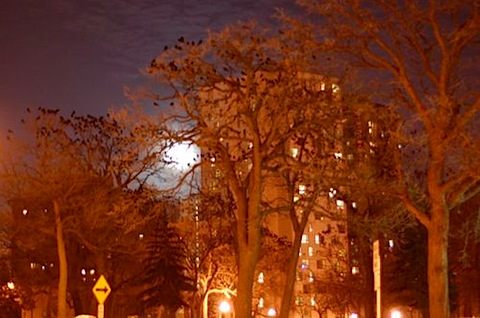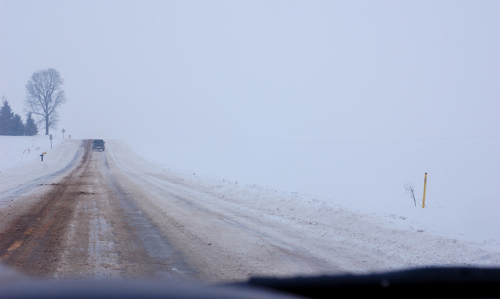[vimeo]http://vimeo.com/19361448[/vimeo] These are a couple of snippets from the Rockstar Storyteller show I did in January 2011. That's my neighbor Zoe reading along with me. This is a piece about a woman who used to call the bird store I worked for who claimed she could psychically communicate with birds.
Thunder Toads
Lang Elliot is one of the coolest guys out there. You may not have heard the name before, but chances are good that if you have listed to any North American bird, mammal, insect or amphibian id CD or tape, you've heard his work (and very likely his voice narrating the tracks). He's got a website called Music of Nature and he's regularly updating some of the nature sounds he's captured. Last night, I stumbled upon his Thunder Toad sounds. He narrates for about 30 seconds to set up the scene and then you get almost five full minutes of American toads trilling, spring peepers peeping and distant thunder from an approaching storm. I lovely reminder of summer for a girl who is watching another four to six inches of snow fall upon the existing 22 inches on the ground.
Unusual Bird Watching Training
For the second time in my life, I have questioned how much I love birds and wondered if I need an intervention. The first time with the Horned Guan Death March , especially in Part 2 of that epic hike up a volcano to see one of the rarest birds in the Americas. But the second time came last week when I did some mandatory training for our fall waterfowl surveys on the upper Mississippi River.

When we do our aerial waterfowl surveys, we fly low. It seems to me that we are right above the trees, but it's about 150 feet off the ground. It's low. Our biggest danger is power lines that run across the river. Most of them are well marked and we have GPS map system on the plane that alerts us to when we are approaching a set. But accidents happen. If I'm going to keep doing these surveys, then the federal government said that I need to have training on plane safety and how to survive a crash, specifically in water. How did we do that?

Why in a pool at a YMCA! That's one of my teammates and me in a makeshift small plane, belted into our seats and about to be dumped face down in the pool to see if we could calmly unbuckle and leave the plane should it submerge in the water. In order to complete the course, we had to do this four times...twice upside down.
I'm not going to lie...it was nerve racking. I survived three out of four times. The fourth time, I got trapped inside the box and had to be pulled out (I was never in any danger, note all the people in the pool). Two people are watching you under water and they knew right away if you were stuck and they pulled you out. I think because on my third attempt, I got a big shot of chlorinated water up my nose and just general fatigue are the reasons I missed on the fourth attempt. And really, the chances of me crashing into water four times in a row in an afternoon are incredibly slim. I have high hopes I'll survive a water crash and even higher hopes that I won't even need to use this training in my lifetime.

Here we are on one of our simulated crashes when they turned us upside down--you can see our toes. I think it was this dunking when I asked myself...how much do I love birds? If this is what I need to do in order to complete my job to watch and count them from a plane, then maybe there is something psychologically wrong with me. But still, even when we did the classroom portion, I asked myself, "Is counting ducks important enough for me to risk not coming home to Non Birding Bill at the end of the day?"
I think what we learn about native duck usage of the upper Mississippi River is important for the long run and it is worthwhile. Honestly, flying in the plane has been fun and seems like an adventure. However, when you're preparing for a worst case scenario (that will most likely never happen) you do play those scenarios in your head and you wonder if you will be ready if that moment comes.
The first day was general classroom work on plane safety and guidelines. We were given examples of plane crashes and outlined all the little things that could have prevented them and the reasons why some people survived and some people didn't. When I first started doing these surveys, I took an online course on crash survival. I chuckled as the training showed little cartoon planes fall to a fiery explosion and then learned that the number one thing that is going to save me in a crash is a positive mental attitude (surprisingly, not a parachute).
Our classroom training reinforced that and we learned the Seven Steps of Survival in a Plane Crash on Water. Any guesses as to what the first step is when the pilot shouts, "May Day, we're going down!" (or some form of profanity) Any idea?
Step one, say, "I'm a survivor!"
Side note: Do not sing it like a Gloria Gaynor song...that's frowned upon. But first things first, you want to mentally psyche yourself up that you will stay calm and get through this. You will survive and end up at home with your family at the end of the day.
You might be surprised to learn that of the Seven Steps, unbuckling your seat belt is Step Six. Before that, you need to (shout, "I'm a survivor!") unplug your helmet, open the plane door (if you're sitting next to it) brace for impact, when you hit the water you want to count to four to give yourself time to for the plane to stop moving and then sit up, find a reference point to the open door (make sure the doorway is still clear) and then you can unbuckle your belt and exit. The last thing you want to do it swim towards the top with a hand up first to check for debris and/or flames on the water (yikes).

The helmets remind me of the movie Spaceballs. The training was fun in a Mythbusters sort of way and a bit morbid, but I'm so grateful that I had it. I'm fortunate in that we have a professional and attentive pilot but I feel more prepared than ever should we have to go down into the river.
All part of the fun and exciting life of being a park ranger.
Bird Like Me
| The Daily Show With Jon Stewart | Mon - Thurs 11p / 10c | |||
| Bird Like Me | ||||
|
||||
Hilarious clip from the Daily Show about a small Mississippi town called Turkey Creek. It was founded by former slaves and was slowly disappearing until it received a little help from Pascagoula River Audubon Center. I love everything about this story from the ingenuity of the town leaders looking for unconventional help to save the town to Mississippi Audubon for having a sense of humor with the Daily Show.
Birders should help this town by going to watch birds there.You can read more about it here.
Great Backyard Bird Count 2011 #GBBC #birding
Mark your calendar now for February 18 - 21, 2011!

Are you seeing pine siskins this winter? You need to report them!
The Great Backyard Bird Count is coming up and is an easy way for you to help track winter bird populations in your yard. Anyone with a remote interest in birds can participate. It doesn't matter if you live in an urban area or a suburban backyard or out in the middle of nowhere--you can document birds. This 4 day event is an attempt to create a real-time snapshot of where the birds are across the continent. Anyone can participate, from beginning bird watchers to experts. It takes as little as 15 minutes on one day, or you can count for as long as you like each day of the event. It’s free, fun, and easy—and it helps the birds. You tally the highest number of birds of each species seen together at any one time. You can fill out an online checklist at the Great Backyard Bird Count website.

A black-capped chickadee chowing down on a deer rib cage. As the count progresses, anyone with Internet access can explore what is being reported from their own towns or anywhere in the United States and Canada. You can also see how this year's numbers compare with those from previous years. Participants may also send in photographs of the birds they see. A selection of images is posted in the online photo gallery.
So, take a look at your calendars and see if you can set aside at least 15 minutes to count birds for 4 days in February, the 18th through the 21st. Maybe make it a fun get together with friends! Invite kids to sit and count with you, make it a fun game. Or make it an early afternoon Birds and Beers with some of your buds to count birds. Whatever, but give it a try this winter.
It's This Cold...Again
I knew it was going to be below zero this morning. But I woke up to -18 degrees Fahrenheit this morning. I'm supposed to lead a Moonlight Snow Shoe tonight at 7pm. If it's this cold then, I wonder if I should take a squirt bottle with me? This is what I did 2 winters ago when it was -21: [youtube]http://www.youtube.com/watch?v=a8Hy1Pxyk-Y[/youtube]
Stupid Hipster Crows
Non Birding Bill and I drove by Loring Park tonight and expected to find this:

But when we arrived there, the crow roost was bare! The roost has moved. As I let loose a stream of profanity as to how this affects Birds and Beers, NBB said, "You know what happened, they arrived around Thanksgiving and said, 'Oh, we were here last year, this place is all played out,' and then another crow said, 'I know this other little spot that's much quieter that no one knows about and is so cool.' See your problem is that you have hipster crows."

Indeed, the roost has officially moved to Elliot Park, not too far away, but we will not get the same view we had at last year's Birds and Beers. We should still see crows fly in but they will most likely not stay at Loring outside of Joe's Garage. Perhaps after it gets dark, we can caravan over to Elliot Park to see the sleeping crows? So Birds and Beers is still on at Joe's Garage for Saturday at 4:30pm. Sounds like we'll have more beer than birds.
RiffTrax Takes On Prairie Chickens
RiffTrax (some of the dudes who were part of Mystery Science Theater 3000) have added their special brand of humor to an Attwater's Prairie Chicken short. I must admit that I bristled a bit when I saw this. I mean, it's one thing for them to make fun of shorts that warned of the dangers of using gasoline for dry cleaning, but my beloved prairie chickens? I took Bill Corbett to task for this and then he looked at me and said, "Booming? Really? Do they have to call what they do booming?"
Non Birding Bill then said, "You don't understand, she has like been to festivals about these birds. She gets up before dawn and then sits in a cold box in the middle of some abandon prairie in freezing weather to watch them."
I got the feeling that Corbett was siding with NBB.
Here's one of my lesser prairie chicken videos, are these birds really that funny and worthy of riffing?
[youtube]http://www.youtube.com/watch?v=CvyjRmHoqfg[/youtube]
And my favorite video of prairie chickens...the prairie chicken cock block:
[youtube]http://www.youtube.com/watch?v=-ETLhZ1JueQ&feature=channel[/youtube]
Okay, RiffTrax, you may win this round.
Turkeys In Trees
 Man, that is a bleak landscape.
Man, that is a bleak landscape.
I went out the other day with Non Birding Bill to look for golden eagles. I know, NBB going birding? What?? Well, we've both been busy doing shows, he went to Las Vegas for the Consumer Electronics Show and then I went to Atlanta for AmericasMart We're basically just two spousal ships passing in the night this month. He was so desperate for my company that he willingly offered to go driving around with me to look for golden eagles. Since it was mostly in the car, he was cool with that, it wasn't like being pestered by bugs looking for sparrows. The landscape was overcast and covered with snow. When we got to the road, we laughed and I asked, "Where is the horizon?"
I was checking for the Golden Eagle survey conducted each winter by The National Eagle Center. We checked the same area where I found goldens last year.

Alas, no golden eagles on the route this year, but lots of bald eagles. After we finished our survey route, we headed to Colville Park in Red Wing, MN and found this bird. See the eagle in the upper left corner? People were practically driving under it.

It appeared to have something wrong with its eye that's facing my camera. It never moved and the bird usually kept it closed. I wonder if it had gotten in a territory battle and got a talon in the eye? Colville is a good place for this bird. There's open water all winter, lots of waterfowl and the nearby power plant stuns fish, leaving an ample food supply. I'm not sure if this bird will recover but it's possible. We've seen healthy one eyed birds come into Frank's banding station. It's not always gloom and doom.

We saw a ton of wild turkeys on our travels, that's NBB grabbing some turkey footage from the car. Turkeys are supposed to be one of the reasons we now have a wintering population of golden eagles along the Mississippi River on the Minnesota/Wisconsin border--the goldens have been observed taking turkeys as prey. We saw quite a few turkeys in trees, you'd drive along and wonder why there were a dozen black garbage bags in the trees and then realize it was a flock of turkeys feeding on sumac berries. Check out this turkey:

Waaaaaaaaay at the top of that tree! That turkey looks like she's surveying her kingdom. There were several turkeys in the tippy tops of the trees, I think something on the ground flushed them up. It's weird to see a turkey so high up. I've seen them in the tops of trees around the beehives, usually after a fox or coyote has moved through. I took turkeys in the tops of trees as a sign that a golden eagle was not actively patrolling this patch of sky. Still, I love the picture of this huge bird balancing on a high branch, watching the surrounding snow covered bluffs.

Here's that same turkey but this time what she looked like through my spotting scope. I may go back to look for goldens again. One day of no birds could just mean they were tucked in the bluffs somewhere.
Golden Eagle To Be Released With Satellite Transmitter
Tuesday, January 18th at 4:oo pm, the National Eagle Center and Audubon Minnesota will release a golden eagle with a satellite-linked tracking device. The release will take place outside Wabasha, MN (along Wabasha County highway 32), near where the bird was captured. This release is part of an on-going project investigating golden eagles that winter in the blufflands region. By tracking, golden eagles known to use the blufflands in winter, researchers hope to better understand migration patterns and breeding origins for these birds. The Golden Eagle Project has already released two golden eagles with transmitters, and hopes to release up to six golden eagles, during this multi-year project. The eagle released in 2009, migrated from western Wisconsin and spent the summer north of the Arctic Circle. Maps detailing the migrations and location of these birds are available here.
“It’s exciting to have the opportunity to track this golden eagle because so little is known about them and their presence here in the blufflands.” Says Project Co-coordinator, Scott Mehus. “That’s why the National Eagle Center is involved in this pioneering effort to understand and protect these amazing birds.”
This release also comes on the heels of the 2011 Wintering Golden Eagle Survey, which took place on Saturday, January 15th, when volunteer observers combed the blufflands looking for these majestic birds. Results are not yet tabulated, but this year’s survey covered several new areas, so there is a good chance the total could top last year’s survey high of 100 golden eagles in southeast Minnesota, southwest Wisconsin and northeast Iowa.
The Golden Eagle Project is a partnership of National Eagle Center and Audubon Minnesota, with support from Minnesota Department of Natural Resources Non-Game Division, Wisconsin Department of Natural Resources, as well as United States Fish and Wildlife Service, Winona District.
